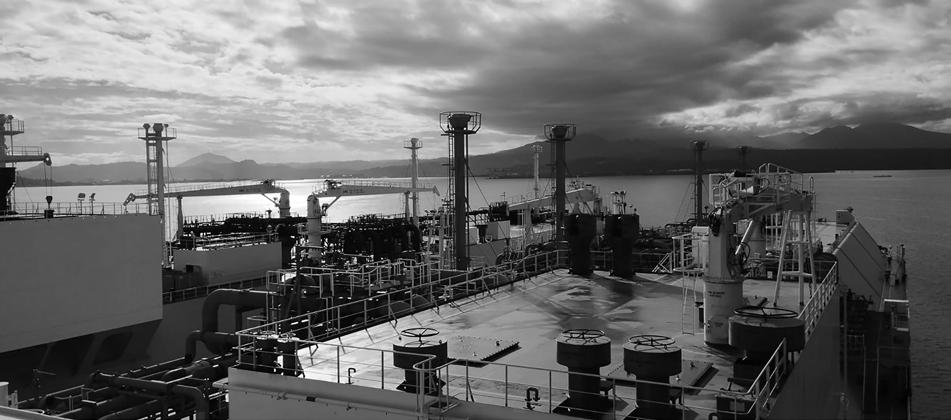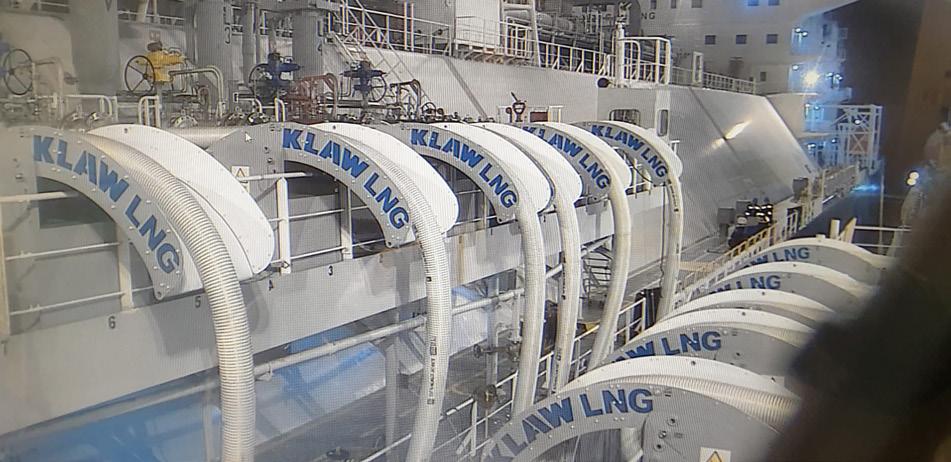
5 minute read
Transfer from A to B
Adam Sanders, STS Marine Solutions Ltd, UK, looks at the benefits of using LNG ship-to-ship transfer throughout all parts of the LNG supply chain, helping to solve the challenges that are arising as the industry evolves.
ver the past few years, the use of LNG has grown significantly, with FSRU terminals becoming more common, LNG bunkering starting to be a regular occurrence, and the global emissions reduction targets seeing LNG being used more frequently as a transition fuel. To allow for these things to happen, a step away from the traditional point-to-point shipping must occur. For many years, LNG ship-to-ship (STS) transfer has been utilised for the replenishment of FSRUs at location, but now the market is seeing traders become more flexible and creative with the approach to the movement of LNG from point-to-point. LNG STS is not only for FSRU bulk transfers, and in this market, threre is a need to be more flexible in the approach to deliver the client’s needs whilst maintaining efficiency in shipping costs. Events between 2020 until now have created a volatile LNG market with prices and supply facing daily changes and challenges. STS Marine Solutions have been working with clients to provide solutions to assist with this by providing expertise to the market for various operations. As stated, the market needs to have flexible solutions to sustain the growth and the varied uses of LNG which are occurring now and look to occur in the future. Next are examples of how the more common use of LNG STS can help the market keep up with the changes in demand and provide flexible solutions to all parts of the supply and use chain. The aim always for this market is to provide not only the most cost-effective but also the most efficient and environmentally sensitive approach. This is key if LNG is


to keep its place as the transition fuel until further devolvements occur for the large scale use of non-hydrocarbon fuels.
Increasing berth availablity
The increased output demand on LNG terminals has made berth availability and scheduling a more critical process. Ensuring the berth is available for offloading carriers is key

Figure 1. Manoeuvring alongside whilst underway.

Figure 2. At anchorage transfer.

Figure 3. Cooldown complete and liquid transfer underway.

Figure 4. Preparing for unmooring. to supplying the growing market, however with the increased prices of LNG and supply needs, traders have in some cases chosen to heel out vessels at the discharge port in order to supply the maximum volume of cargo. This has the downside of arrival at the loading port of a warm vessel requiring a cooldown, and with the increased demand of supply, this is not always an option for berth availability. Working closely with the traders and the port operators, LNG STS has been successfully used to increase the berth availability and maintain the supply chain efficiency for all sides. This option for cooldown has not only been used for heeled-out vessels but also for vessels out of dry dock or long maintenance periods in order to be able to present a cold vessel for loading.
Moving cargos between ship classes
The growing trend for the use of LNG as a fuel has and will lead to more small and large scale LNG facilities popping up globally. This has been very evident in Europe, within excess of five new FSRU terminals in the planning and development stage. The market has grown very used to the FSRU market and the need for a more environmentally friendly fuel, when compared to heavy fuels. However, the smaller scale market is something that is set to grow, and the company will play a role in ensuring the efficiency of supply to such a project. In line with the growth in the LNG market, the diversity of ship types has continued to grow, with more efficient vessels coming out of yards y/y. However, increased efficiency does not always mean increased flexibility – with some berths globally draft and volume restricted, there is still a need for creative trading in order to deliver the suitable vessel with cargo to the berth. LNG STS options have been used to move cargos between ship classes, allowing traders to utilise the more efficient larger vessels for large portions of the journey before transferring to a more terminal-specific vessel for the smaller section; this provides the benefit of reduced boil-off and environmental impact whilst still delivering the parcels on time to the end user.
Amalgamating small cargos
A final example of LNG STS options in the market, which is linked to the development of LNG vessels, is that as part of the drive for greater efficiency from trader and shipping companies, many LNG vessels have increased the capacity of which they can carry from point-to-point. This is great when looking at the cost of movement per unit, but can also create issues with excess cargo when looking at loading into ports with limited storage capacity. This can leave ships in the difficult position with a small parcel remaining onboard with no discharge port for such a small amount. LNG STS has been, and will be more in the future, utilised to amalgamate such parcels at strategic STS locations. This again captures the efficiency of the larger vessels bringing the cargo to a location without leaving a partially loaded vessel.
Conclusion
The changing LNG market presents unique challenges to manage the supply chain to ensure that not only on-time deliveries occur, but also safe, efficient, and suitable methods are used. In this article are just a few examples of how LNG STS can be utilised to provide the solutions to traders to ensure LNG continues its growth to bridge the transition from fuel oil through to non-hydrocarbons fuels on a large scale.










